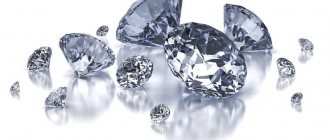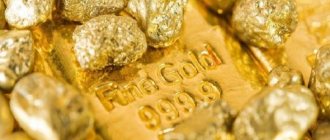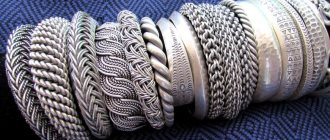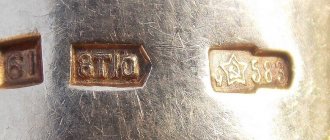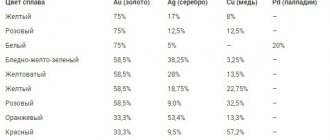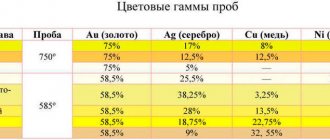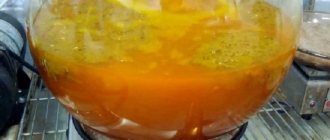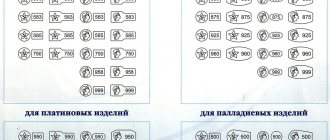| Gold | |
| Atomic number | 79 |
| Appearance of a simple substance | Soft malleable yellow metal |
| Properties of the atom | |
| Atomic mass (molar mass) | 196.96654 a. e.m. (/mol) |
| Atomic radius | 146 |
| Ionization energy (first electron) | 889.3 (9.22) kJ/mol () |
| Electronic configuration | [Xe] 4f14 5d10 6s1 |
| Chemical properties | |
| Covalent radius | 134 |
| Ion radius | (+3e) 85 (+1e) 137 |
| Electronegativity (Pauling) | 2,54 |
| Electrode potential | Au←Au-3 1.50 V Au←Au+ 1.70 V |
| Oxidation states | -3, 1 |
| Thermodynamic properties of a simple substance | |
| Density | 19,3 /³ |
| Molar heat capacity | 25.39[1]/(mol) |
| Thermal conductivity | 318 /(·) |
| Melting temperature | 1337,58 |
| Heat of Melting | 12.68 kJ/mol |
| Boiling temperature | 3080 |
| Heat of vaporization | ~340 kJ/mol |
| Molar volume | 10.2 ³/mol |
| Crystal lattice of a simple substance | |
| Lattice structure | cubic face-centered |
| Lattice parameters | 4,080 |
| c/a ratio | n/a |
| Debye temperature | 170,00 |
| Au | 79 |
| 196,96654 | |
| [Xe]4f145d106s1 | |
| Gold | |
Gold
- an element of a secondary subgroup of the first group, the sixth period of the periodic table of chemical elements, with atomic number 79. Denoted by the symbol Au (Latin Aurum).
The simple substance gold (CAS number: 7440-57-5) is a noble metal of yellow color. Diagram of a gold atom
Proto-Slavic *zolto (Russian gold, Ukrainian gold, Old Slavic gold, Polish złoto) is related to Lit. geltonas "yellow", Latvian. zelts "gold, golden"; with different vocalism: goth. gulþ, German Gold, English gold; further Skt. hiraṇyam, Avest. zaranya "gold", also Skt. hari "yellow, golden, greenish", from the Proto-Indo-European root *ǵʰel- "yellow, green, bright". Hence the names of the colors: yellow, green.
Connection with the root “sun” ( sol
, other Greek ἥλιος) is doubtful.
STRUCTURE
Crystal structure of gold
Crystallizes in the cubic system, in the form of octahedra, rhombic dodecahedrons, cubes and more complex crystals; Often they are distorted, strongly elongated, forming “wires”, “hairs”, or flattened parallel to the edge of the octahedron. Native gold, especially low-grade gold, is characterized by a variety of growth forms; it is usually in the form of skeletal crystals, dendrites, thread-like and twisted-filamentary crystals. Streak-like and irregular lump-like, “hooked” discharges are widespread; Their surfaces often contain imprints of crystals of other minerals, the aggregates of which included accumulations of native gold. Etching reveals the crystalline granular structure of the gold particles.
Best cleaning result
Pure gold is 999 fine or 24 carats according to the European system. This kind of gold is also called red gold. It is used to produce bars that fill vaults and coins that are usually purchased by collectors. In the east, jewelry is even made from gold of this standard. In our everyday life, such gold is used for top coating and gilding. It can be used on jewelry, watches, furniture, figurines, and interior objects. Such a layer will not only protect from external influences, due to the increased inertness of the metal, but will also add nobility to antique-finished objects.
The question of how many carats are in a bar should not arise in pure gold. The purest sample is called “five nines” because its value looks like 99.999. It corresponds to 1000 in fineness and 24 in carats. Its color is natural yellow. The surface is shiny, the metal itself is very soft, it can be scratched with a fingernail. One of its advantages is malleability and ductility. The material is so malleable that it can be stretched to enormous lengths with microscopic thickness, or, on the contrary, flattened into the thinnest sheet without violating the integrity of the metal. Bank gold, which is quoted on the international market, corresponds to the figure of four nines (99.99).
PROPERTIES
Gold bars and nuggets
Gold is a very heavy metal: the density of pure gold is 19.32 g/cm³ (a ball of pure gold with a diameter of 46.237 mm has a mass of 1 kg). Diamagnetic, that is, the magnetic field in gold weakens. Among metals, it ranks seventh in density after osmium, iridium, rhenium, platinum, neptunium and plutonium. Tungsten has a density comparable to gold (19.25). The high density of gold makes it easier to extract, which is why even simple technological processes - for example, washing at sluices - can provide a high degree of gold recovery from the washed rock. Gold is a very soft metal: hardness on the Mohs scale is ~2.5, on the Brinell scale 220-250 MPa (comparable to the hardness of a fingernail). Gold is also highly ductile: it can be forged into sheets up to ~0.1 µm (100 nm) thick (gold leaf); With such a thickness, gold is translucent and in reflected light has a yellow color, in transmitted light it is colored bluish-greenish, complementary to yellow. Gold can be drawn into wire with a linear density of up to 2 mg/m. The melting point of gold is 1064.18 °C (1337.33 K), boils at 2856 °C (3129 K). The density of liquid gold is less than solid gold and is 17 g/cm3 at the melting point. Liquid gold is quite volatile and actively evaporates long before its boiling point.
What stones go best with gold in jewelry?
18K Gold Carved Ruby Ring by ARTISAN
Gold is so versatile that it goes well with all stones. An exception is aquamarine on white gold - on it it is almost invisible and is lost from attention, but some will like this option. Also, some consider it unacceptable to combine bright red stones (for example, garnet or ruby) with yellow gold. But, again, this is a matter of taste.
RESERVES AND PRODUCTION
Golden Nugget
The gold content in the earth's crust is very low - 4.3·10-10% by weight (0.5-5 mg/t), but deposits and areas sharply enriched in the metal are very numerous. Gold is also found in water. One liter of both sea and river water contains less than 5·10−9 grams of Au, which approximately corresponds to 5 kilograms of gold in 1 cubic kilometer of water. Gold deposits occur predominantly in areas of granitoid development; a small number of them are associated with basic and ultrabasic rocks. To obtain gold, its basic physical and chemical properties are used: its presence in nature in a native state, the ability to react with only a few substances (mercury, cyanide). With the development of modern technologies, chemical methods are becoming more popular. In 1947, American physicists Ingram, Hess and Haydn conducted an experiment to measure the effective cross section for the absorption of neutrons by mercury nuclei. As a side effect of the experiment, about 35 micrograms of gold was obtained. Thus, the centuries-old dream of alchemists was realized - the transmutation of mercury into gold. However, such gold production has no economic significance, since it costs many times more than extracting gold from the poorest ores.
History of the name
Gold is the first metal mastered by man. In South Africa, which is called the “cradle of humanity,” and in a number of other places on the planet in the Neolithic era (the later period of the Stone Age), “yellow stones” were found along the river valleys where “Homo sapiens” lived. These bright, “sun-like stones” also occupied an important place in magical rituals. They were worshiped and believed that amulets made from them would save them from troubles. Gold was also a symbol of wealth. This is indicated by burials discovered in modern times. For example, near Lake Varna, in Bulgaria, graves were excavated that contained gold jewelry made about seven thousand years ago.
When the cult of religions was just beginning, gold became one of the first objects of religious worship. For our ancestors it embodied the Sun God. It was the sun, they argued, that gave birth to the gold that once rained on the earth. Gold is like the sun and that is why it was called “radiant”. The “solar” name for gold can be traced in different languages of the world. The word “aurum” was spread in Latin-speaking countries; it goes back to the name Aurora, which was the name of the Goddess of the dawn. The Indo-European name (root) “gol” means “brilliant”, “desirable”) became the basis for the English and German word “gold”. In the Slavic name “gold” “metal”, as in other countries, there are some similarities with some meanings denoting sunlight and sun. In D. I. Mendeleev’s periodic table of elements, gold occupies the 79th cell.
ORIGIN
Gold products
Native gold is the main form of gold found in nature. It is concentrated in hydrothermal deposits forming gold ores, unevenly distributed in fractured vein quartz and in sulfides - pyrite, arsenopyrite, pyrrhotite, etc. In essentially sulfide ores, native gold is finely dispersed. During the oxidation of ores on the earth's surface, fine native gold is partially dissolved and redeposited; in some cases it enriches the upper parts of ore bodies. The processes of their destruction lead to the release of particles of native gold and their accumulation in placers; moving with water flows together with other plastic material, the particles become rounded, rounded, deformed, and partially recrystallized; As a result of electrochemical corrosion, a thin shell of high-fine gold is formed on them, which leads to a general increase in the standard of native gold in placers.
How gold is mined
North-Eastern Siberia, Kuranakh ore field.
Photo: PJSC Polyus Gold mining is carried out in the following countries: South Africa, Australia, USA, Canada, Russia, China and Pakistan. One of the largest gold mines is the Aurora mine, located in Guyana, Africa.
In ancient times, pieces of gold were simply found in a river or earth. During the Gold Rush, gold was mined by hand using a pick and shovel. By 1853, hydraulic mining had emerged and replaced independent gold miners. Today, gold is mined in large open-pit or underground mines.
The process begins with geologists taking samples of the ore to determine the best places to mine. Once mining engineers know where the gold is and what other materials surround it, the mining process can begin.
Advertising - Continued below
If gold is located close to the surface, it is mined by open-pit mining. In fact, a huge hole is dug in the ground, along the inner perimeter of which a road goes down like a spiral. Equipment for mining and moving ore goes down and up along this road.
APPLICATION
Golden coins
In terms of its chemical resistance and mechanical strength, gold is inferior to most platinum group metals, but is irreplaceable as a material for electrical contacts. Therefore, in microelectronics, gold conductors and gold electroplating of contact surfaces, connectors, and printed circuit boards are used very widely. Gold is used as a target in nuclear research, as a coating for mirrors operating in the far infrared range, and as a special shell in a neutron bomb. A thin layer of gold (20 nm) on the inner surface of window and stained glass glass significantly reduces unwanted heat losses in winter, and in summer it protects the interior of buildings and vehicles from heating by infrared rays. Gold solders wet various metal surfaces very well and are used in metal soldering. Thin gaskets made from soft gold alloys are used in ultra-high vacuum technology. The traditional and largest consumer of gold is the jewelry industry. Jewelry is made not from pure gold, but from its alloys with other metals, which are significantly superior to gold in mechanical strength and durability. Currently, Au-Ag-Cu alloys are used for this, which may contain additives of zinc, nickel, cobalt, and palladium. The corrosion resistance of such alloys is determined mainly by their gold content, and the color shades and mechanical properties are determined by the ratio of silver and copper. Dentistry consumes significant amounts of gold: crowns and dentures are made from alloys of gold with silver, copper, nickel, platinum, and zinc. Such alloys combine corrosion resistance with high mechanical properties. Gold compounds are included in some medications used to treat a number of diseases (tuberculosis, rheumatoid arthritis, etc.). The radioactive isotope 198Au (half-life 2.967 days) is used in the treatment of malignant tumors in radiotherapy.
Gold - Au
| Molecular weight | 196.97 g/mol |
| origin of name | Proto-Slavic “*zolto” (“gold”) is related to Lit. geltonas "yellow", Latvian. zelts "gold". |
| IMA status | valid, first described before 1959 (before IMA) |
The influence of alloying components on the hardness and strength of the alloy
Copper, platinum, palladium and nickel are the main elements that form solid solutions with gold. They give the alloy hardness and higher strength.
Shlychkova V.S. and Starchenko I.P. in their article about alloying additives in gold note: the more the atomic radius of gold and impurities differ from each other, the more durable the alloy becomes. For example, adding 50 at.% silver to gold almost does not change its hardness, while 50 at.% nickel increases the hardness of gold by almost 15 times!
Changes in the strength of gold when alloying it with various elements
Depending on the density of its constituents, a gold alloy can be hard and durable, or hard and brittle.
The impurities in gold of tin, sulfur, antimony and bismuth are harmful to the alloy as they make it very brittle!
PHYSICAL PROPERTIES
| Mineral color | rich yellow, fading to white-yellow with a predominance of silver |
| Stroke color | brilliant yellow |
| Transparency | opaque |
| Shine | metal |
| Cleavage | No |
| Hardness (Mohs scale) | 2,5-3 |
| Strength | malleable |
| Kink | jagged |
| Density (measured) | 15 - 19.3 g/cm3 |
| Radioactivity (GRapi) | 0 |
| Magnetism | diamagnetic |

